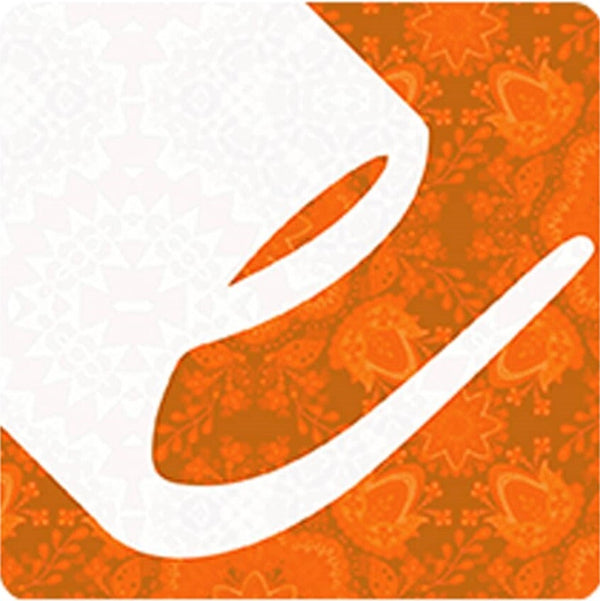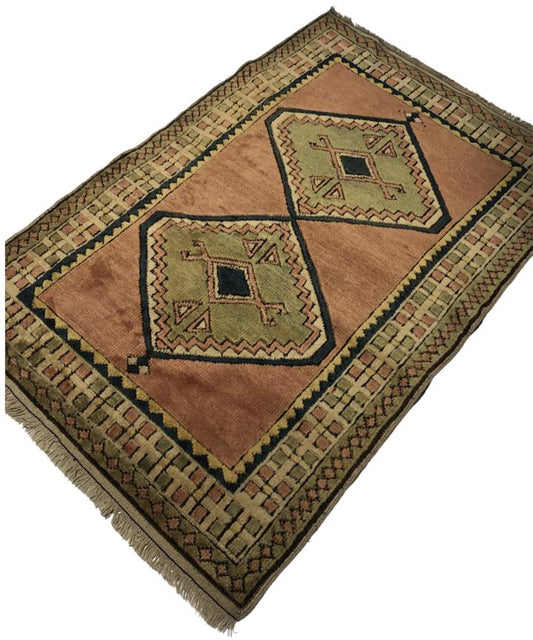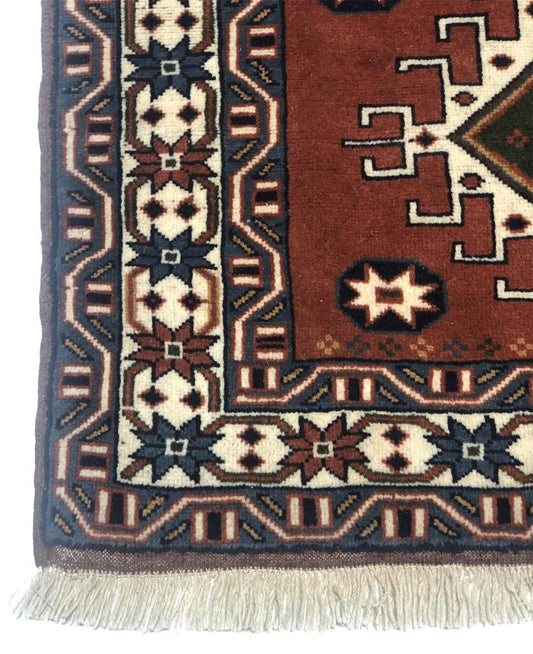Collection: Turkish Rugs
Our Turkish Rugs are renowned handcrafted textiles originating from Turkey by using high quality wools. With double knot technique, our Turkish carpets are highly durable and withstand heavy foot traffic while maintaining their vibrant appearance. Made from natural dyes, each carpet brings you a natural appearance to your home.
-
Turkish Rug 132cm x 87cm
Regular price £250.00 GBPRegular priceUnit price / per£500.00 GBPSale price £250.00 GBPSale -
Turkish Rug 136cm x 95cm
Regular price £200.00 GBPRegular priceUnit price / per£500.00 GBPSale price £200.00 GBPSale -
Turkish Rug 150cm x 104cm
Regular price £250.00 GBPRegular priceUnit price / per£400.00 GBPSale price £250.00 GBPSale -
Turkish rug 190cm x 125cm
Regular price £270.00 GBPRegular priceUnit price / per£600.00 GBPSale price £270.00 GBPSale
Antique Turkish Rugs and Carpets in London UK
Our Antique Turkish rugs are made with hand knotted especially using double knot technique which is common Turkish carpet weaving technique. The ends border of our Turkish rugs are well-made fringed borders and quite durable. We feature medallion designs in our Turkish rugs with the variations of different colors including terracotta, cream, almond hues and brown hues.
Turkish Rugs for Sale
On average the price of Turkish rugs starts from the £800 for the small rugs and ends up to the £3,000+ for the large rugs in the United Kingdom. However, Eram Rugs brings you the sale for Turkish rugs in London UK where our Turkish carpet collection starts from £200 for a medium-sized rug. Other than Turkish rugs we have Persian and Russian rugs as well at the best price.
Turkish Rugs 8x10 Feet | 244 cm by 305 cm
Our Turkish rug sizes start from (136cm x 95cm) and end up to (190 cm x 125cm). However, we don’t have the 8x10 Turkish rug size, but we have Turkish rugs close to this size accordingly.
We have the following Turkish rugs sizes below.
Turkish Rug 132cm x 87cm (approximately 4.3 x 2.8 feet):
You can easily place this size of Turkish rug in your entryway, or hallway where it can work as a runner. In the kitchen and small bedroom.
Turkish Rug 150cm x 104cm (approximately 5 x 3.4 feet):
For this size of Turkish rug, it can be easily suited for the living room under the small coffee table or at the home office.
Turkish Rug 190cm x 125cm (approximately 6.2 x 4 feet):
This Turkish Rug size is best suited for the living room, dining room, and bedroom.
Turkish Rug 136cm x 95cm (approximately 4.4 x 3.1 feet):
This medium Turkish size is best suited for the bathroom, entryway, and bedroom.
Frequently asked questions
What are Turkish Rugs?
Turkish rugs, also known as Anatolian rugs, are handwoven textiles that have been crafted in Turkey for centuries. Renowned for their intricate designs, vivid colors, and high-quality craftsmanship, these rugs are not just functional items but also significant cultural artifacts that reflect the rich history and traditions of Turkey.
Definition and Meaning
At their core, Turkish rugs are floor coverings created using traditional weaving techniques that have been passed down through generations. The term "Turkish rug" encompasses a variety of styles and types, including knotted pile rugs and flat-woven kilims, each with unique characteristics and regional influences. The most common knot used in these rugs is the Ghiordes knot, which enhances the durability and lushness of the fabric.
What are Turkish Rugs Made Of?
Turkish rugs are primary made up of natural materials including wool, silk, cotton and goat hair. In some regions of Turkey, such as Eastern Anatolia, goat hair is used in addition to wool. The combination of wool and goat hair creates a durable and textured rug. Silk rugs are often considered the most valuable type of Turkish rug.
What Are Turkish Rugs Worth?
The prices of Turkish rugs can range from £120 to £22,000 or more, depending on these factors. For example, a simple vintage Turkish rug might cost around £350, while a rare antique Oushak rug could fetch prices upwards of £10,000.
If Turkish rug is 100 years old, then it’s often more valuable than the newer pieces. Rugs with intricate designs, vibrant colors, and unique patterns tend to be more valuable.
For example, Hereke rugs, known for their detailed artistry and use of silk, can reach prices of £9,500 or more.
The materials used in Turkish rugs also affect their worth. Wool rugs are common and generally less expensive, while silk rugs are rarer and often much more valuable.
A fine silk rug can be priced at £5,000 to £20,000, depending on its intricacy and age. The origin of the rug can also influence its value.
Rugs from well-known regions, such as Oushak, Bergama, or Hereke, are often more sought after by collectors.
Are Turkish Rugs Good Quality?
Yes, Turkish rugs are renowned for their high quality, due to their craftsmanship, use of durable materials like wool and silk, and the double-knot weaving technique, which not only enhances the rug’s strength but also ensures it maintains its vibrant colors and intricate patterns over time.
How do I identify a Turkish rug?
To identify a Turkish rug, take a look at the back of it. The knots on the back of the woven rug are a clear sign of its hand embroidery. If it's hand-knotted, you’ll notice an asymmetrical pattern, which is easy to spot as each stitch is carefully tied.
What are the Types of Turkish Rugs?
The Turkish rug types include Kilim, Oushak, Hereke rugs, bergama, Cicim and Sumak rugs. which are known for their vibrant patterns and meticulous craftsmanship. Each type of Turkish rug reflects a different aspect of the country's rich weaving traditions. The main types of Turkish rugs include:
Kilim Rugs: Flat-woven and known for their bold geometric patterns and bright colors.
Oushak Rugs: Famous for their soft, muted colors and large floral designs.
Hereke Rugs: Renowned for their intricate designs and high-quality silk craftsmanship.
Bergama Rugs: Characterized by vibrant colors and strong medallion motifs.
Cicim Rugs: Embroidered rugs known for colorful designs and intricate details.
Sumak Rugs: Flat-woven rugs that feature bold colors and geometric patterns.
What type of knots are used in making Turkish rugs?
Turkish rugs predominantly use symmetrical (Turkish or Ghiordes) knots.
What is the knot density in Turkish rugs?
The knot density in Turkish rugs ranges from 80 to 200 knots per square inch (KPSI), depending on the rug's design and quality.
What is the typical pile height for Turkish rugs?
The pile height of Turkish rugs varies between 5 and 12 mm, influenced by the type of rug and its weaving technique.
What colors are commonly used in Turkish rugs?
Turkish rugs often use a color palette of rich reds, blues, creams, and earth tones, frequently dyed with natural vegetable dyes.
What designs are common in Turkish rugs?
Turkish rugs feature geometric patterns, floral motifs, and stylized animals, often incorporating tribal or medallion designs.
What sizes do Turkish rugs come in?
Turkish rugs are available in sizes ranging from small (3' x 5') to large (10' x 14').
How long is the fringe on Turkish rugs?
The fringe length on Turkish rugs generally measures 1-2 inches.
What materials are used for the fringe on Turkish rugs?
The fringe on Turkish rugs is typically made from either wool or cotton.
How durable are Turkish rugs?
Turkish rugs are highly durable due to their dense wool pile and strong knotting, suitable for both residential and commercial use.
How thick are Turkish rugs?
The thickness of Turkish rugs ranges from 8 to 12 mm.
How much do Turkish rugs typically weigh?
They weigh about 4-5 kg per square meter, varying slightly with the rug's density and materials.
How are Turkish rugs classified by age?
Turkish rugs are categorized as New (less than 20 years), Semi-antique (20-50 years), and Antique (50+ years).
What is the cultural significance of Turkish rugs?
Turkish rugs are often used as symbols of status, protection, or storytelling within their cultural contexts.
How are the edges of Turkish rugs finished?
The edges are typically finished with hand-sewn selvage to prevent unraveling.
Are Turkish rugs stain-resistant?
Yes, they are naturally stain-resistant due to the lanolin in the wool.
How do Turkish rugs handle moisture?
Wool in Turkish rugs can absorb up to 30% of its weight in moisture without feeling damp, offering good moisture resistance.
How resistant to fading are Turkish rugs?
Turkish rugs have a high resistance to fading, especially those dyed with natural vegetable dyes.
Are Turkish rugs resistant to moths?
Yes, the natural lanolin content in wool makes Turkish rugs naturally resistant to moths.
Do patterns vary much among Turkish rugs?
Yes, there is a high variation in patterns due to the individual weaver’s artistic expression.
How well do Turkish rugs withstand abrasion?
Turkish rugs have high abrasion resistance due to their dense weave and durable materials.
What maintenance do Turkish rugs require?
They require professional cleaning every 2-3 years and regular vacuuming to maintain their appearance.
What is the sheen like on Turkish rugs?
Turkish rugs have a medium to low sheen, which can increase with foot traffic and age, particularly in wool and silk rugs
What is the resale value of Turkish rugs?
Turkish rugs, especially antiques, have a high resale value and often appreciate over time.
How adaptable are Turkish rugs to different climates?
Turkish rugs perform excellently in both cold and moderate climates, thanks to the insulating properties of wool.
What is the tensile strength of Turkish rugs?
The wool fibers in Turkish rugs have a tensile strength of about 500-600 N/cm², contributing to their durability.
What weaving techniques are used for Turkish rugs?
Turkish rugs are either hand-knotted or flat-woven. Kilims are typically flat-woven, while more traditional rugs are hand-knotted.




